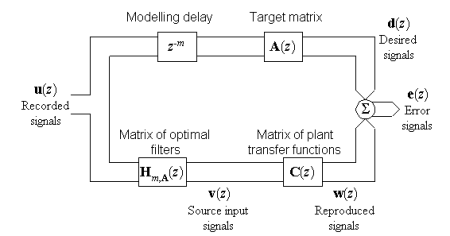|
Whether the objective is to design
a cross-talk canceller or a virtual source imaging system, the fundamental
problem to be tackled is one of multi-channel inversion.

Since the inversion techniques
that are usually applied to common engineering problems are not entirely
appropriate for audio purposes, we have developed our own filter design
methods. These methods can determine a matrix of digital finite impulse
response (FIR) filters that are optimal in a quantifiable sense. The idea
central to our filter design algorithms is to minimise, in the least squares
sense, a cost function of the type
J=E+bV
The cost function is a sum of two
terms: a performance error E, which measures how well the desired
signals are reproduced at the target points, and an effort penalty bV
which is a quantity proportional to the total power that is input to all
the loudspeakers. The positive real number b is a regularisation
parameter that determines how much weight to assign to the effort term.
By varying b from zero to infinity, the solution changes gradually
from minimizing the performance error only to minimizing the effort cost
only. In practice, this regularisation works by limiting the power output
from the loudspeakers at frequencies at which the inversion problem is
ill-conditioned. This is achieved without affecting the performance of
the system at frequencies at which the inversion problem is well-conditioned.
In this way, it is possible to prevent sharp peaks in the spectrum of the
reproduced sound. If necessary, a frequency dependent regularisation parameter
can be used to attenuate peaks selectively. We always include a modelling
delay in order to allow the optimal filters to compensate for non-minimum
phase components in the plant. We do not favour the use of minimum phase
approximations since these can alter the time structure of the original
waveform. |

